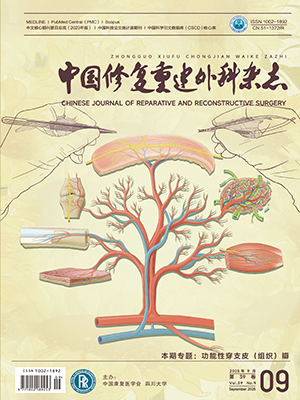| 1. |
Santanelli F, Longo B, Germano S, et al. Total breast reconstruction using the thoracodorsal artery perforator flap without implant. Plast Reconstr Surg, 2014, 133(2):251-254.
|
| 2. |
Amin AA, Rifaat M, Ellabban MA, et al. Transaxillary thoracodorsal artery perforator flap:a versatile new technique for hypopharyngeal reconstruction. J Reconstr Microsurg, 2014, 30(6):397-404.
|
| 3. |
Kim SW, Kwon YH, Kim JT, et al. Foot reconstruction using a serratus anterior muscle flap from the same donor site after failure of a thoracodorsal artery perforator flap. Microsurgery, 2014, 34(2):153-156.
|
| 4. |
Hamdi M, Decorte T, Demuynck M, et al. Shoulder function after harvesting a thoracodorsal artery perforator flap. Plast Reconstr Surg, 2008, 122(4):1111-1119.
|
| 5. |
沈鹏, 高志强. 胸背动脉穿支皮瓣的解剖研究和临床应用进展. 中国美容整形外科杂志, 2009, 20(6):369-372.
|
| 6. |
张功林, 郭翱, 章鸣, 等. 胸背动脉穿支游离皮瓣修复前臂创面部分坏死一例. 中华整形外科杂志, 2008, 24(6):485.
|
| 7. |
肖海涛, 时莹瑜, 王怀胜, 等. 高频彩色多普勒超声检测穿支血管在股前外侧穿支皮瓣手术中的应用. 中国修复重建外科杂志, 2013, 27(2):178-181.
|
| 8. |
Lin CT, Huang JS, Hsu KC, et al. Different types of suprafascial courses in thoracodorsal artery skin perforators. Plast Reconstr Surgery, 2008, 121(3):840-848.
|
| 9. |
Malhotra A, Chhaya N, Nsiah-Sarbeng P, et al. CT-guided deep inferior epigastric perforator (DIEP) flap localization-better for the patient, the surgery, and the hospital. Clin Radiol, 2013, 68(2):131-138.
|
| 10. |
陶友伦, 陈绍鹤, 徐世敏, 等. 大鼠皮动脉外径与其营养范围的定量测量和回归分析. 中国临床解剖学杂志, 2009, 27(5):558-562.
|
| 11. |
Tao Y, Hu S, Lui KW, et al. Quantitative regression analysis of the cutaneous vascular territories in a cat modal. Surg Radiol Anat, 2011, 33(9):789-799.
|
| 12. |
唐茂林, 徐达传. 穿支皮瓣解剖学研究中存在的问题及对策. 中国临床解剖学杂志, 2006, 24(2):225-227.
|
| 13. |
楼新法, 梅劲, Christopher R.Geddes, 等. 明胶-氧化铅血管造影术的优化. 中国临床解剖学杂志, 2006, 24(2):259-262.
|
| 14. |
崔磊, 胡春洪, Sanjeev PS, 等. 下肢动脉64层CT血管成像两种成像方法图像质量的比较. 中华放射学杂志, 2009, 43(3):284-289.
|
| 15. |
马春梅, 宫凤玲, 陈伟彬, 等. 自动跟踪与手动触发技术在256层CT冠状动脉成像中的应用. 实用放射学杂志, 2013, 29(11):1844-1846.
|
| 16. |
付传明, 徐霖, 陈伦刚, 等. MSCT对不同体重注射不同对比剂量在主动脉CTA中的探讨. CT理论与应用研究, 2011, 20(2):251-258.
|
| 17. |
Su W, Lu L, Lazzeri D, et al. Contrast-enhanced ultrasound combined with three-dimensional reconstruction in preoperative perforator flap planning. Plast Reconstr Surg, 2013, 131(1):80-93.
|
| 18. |
陈世新, 丁茂超, 崔怀瑞, 等. 腹壁下动脉穿支皮瓣的3D可视化研究. 解剖学报, 2011, 42(2):269-273.
|
| 19. |
Chiu WK, Lin WC, Chen SY, et al. Computed tomography angiography imaging for the chimeric anterolateral thigh flap in reconstruction of full thickness buccal defect. ANZ J Surg, 2011, 81(3):142-147.
|
| 20. |
Grover R, Nelson JA, Fischer JP, et al. The impact of perforator number on deep inferior epigastric perforator flap breast reconstruction. Arch Plast Surg, 2014, 41(1):63-70.
|
| 21. |
Angrigiani C, Rancati A, Escudero E, et al. Propeller thoracodorsal artery perforator flap for breast reconstruction. Gland Surg, 2014, 3(3):174-180.
|




